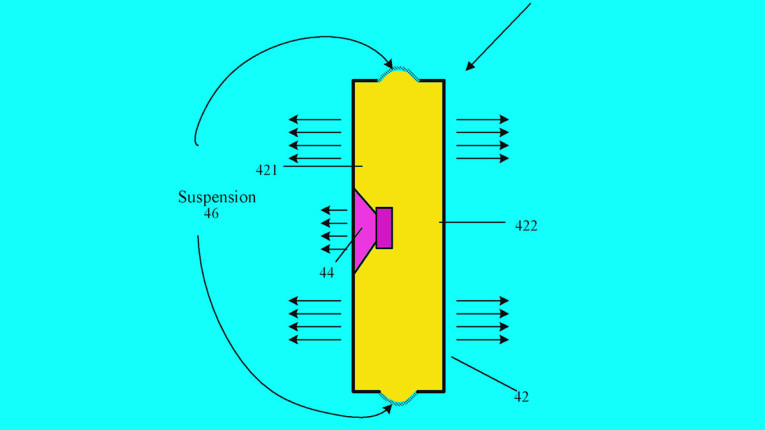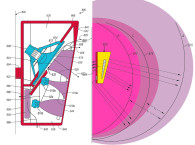
Speaker
Patent Number: 9,674,594
Inventor: Shengbo Li (Guangdong, CN)
Assignee: Harman International (China) Holdings Co., Ltd. (Shenzhen, Guangdong, China); Harman International Industries, Inc. (Stamford, CT)
Filed: May 8, 2012
Current CPC Class: H04R 1/026 (20130101)
Granted: June 6, 2017
Number of Claims: 19
Number of Drawings: 6
Abstract from Patent
A speaker including one or multiple transducers, an enclosure, and a suspension mounted on the enclosure, wherein the suspension and the enclosure are configured such that the enclosure is capable of vibrating as a result of operation of the transducer so as to produce audible sound.
Independent Claims
1. A speaker comprising a transducer, an enclosure, and a suspension mounted on the enclosure, wherein the suspension and the enclosure are configured to promote vibration of the enclosure as a result of operation of the transducer so as to produce audible sound, wherein the enclosure comprises at least a first portion and a second portion with the suspension connected there between, wherein the suspension is positioned on an outer surface of the enclosure and a first axis extends through the suspension, and wherein the transducer is positioned on the outer surface of the enclosure and a second axis extends through the transducer, the first axis being perpendicular to the second axis.
12. A speaker comprising: a transducer; an enclosure including a first portion and a second portion that is separate from one another; and a suspension positioned between the first portion and the second portion, wherein the suspension and the enclosure are configured to promote vibration of the enclosure as a result of operation of the transducer to produce an audible sound, wherein the suspension is positioned on an outer surface of the enclosure and a first axis extends through the suspension, and wherein the transducer is positioned on the outer surface of the enclosure and a second axis extends through the transducer, the first axis being perpendicular to the second axis.
Reviewer Comments
In the last few years, there have been a number of patent filings on new architectures for passive radiators, particularly ones that are used in small, mobile devices. One of the problems is that with such small packages, it is difficult to provide enough diaphragm surface area for both the active transducers and the passive acoustic diaphragms.
Some of the more interesting developments have been those by the late Godehard A. Guenther, US Patent 8,189,840, “Loudspeaker and Electronic Devices Incorporating the Same,” wherein the device battery is configured with a surround suspension to do double duty as both the DC power source and as a vibratile passive diaphragm radiator, providing both the mass and surface area required for low-frequency, Helmholtz tunings in a small enclosure.
Others variations on the theme of maximizing the diaphragm radiating area as a percentage of the total outer surface area of loudspeaker device or a loudspeaker incorporated into an active portable system include:
US Patent 7,953,239, “High Output Subwoofer” by William A. Decanio, of Harman Industries; configuring a six-sided enclosure with two opposing active woofers and passive radiators on the remaining four sides of the enclosure (cited in Li)
US Patent 6,389,146 and US Patent 7,103,193, “Acoustically Asymmetric Bandpass Loudspeaker with Multiple Acoustic Filters” by James J. Croft, III, assigned to American Technology Corp. (cited in Li)
US Patent 7,158,648, “Loudspeaker System with Extended Bass Response,” by Aaron L. Butters, et al, assigned to Harman International; Configuring the front panel of a loudspeaker enclosure outside of the circumference of the active transducer
US Patent 9,042,582, “Coaxial Passive Radiation Monomer” by Matthew Chi-Hung Chan, et al, assigned to Plastoform Industries; Fabricating a passive radiator, as a part of a transducer, around the circumference of the transducer
Recently, this was taken one step further by attempting to use the active transducer as the passive radiator, such as found in Joseph Y. Sahyoun’s US Patent 9,294,841, “Acoustic Radiator Including a Combination of a Co-Axial Audio Speaker and Passive Radiator.”
In the Sahyoun concept there is a surround/suspension around the perimeter of the frame of the transducer, suspending it from the front baffle, where the complete active transducer structure (diaphragm and frame) is the passive diaphragm radiator. The total mass of the active transducer assembly is translated as the acoustical mass of the passive radiator. The active transducer diaphragm then becomes a significant portion of the surface area of the “effective” passive radiator.
I have not yet tested or simulated such a system, but while, ideally, it would be advantageous as an efficient use of surface area, there are several concerns that come to mind.
First, even if the utility of the system is a positive, the actual mass of the active transducer, with frame and magnet as the majority of the “passive” moving mass (which is not easily reduced), may result in too much acoustic mass for the desired tuning frequency for all but the very smallest of enclosure volumes and acoustic compliances.
Second, in a standard bass reflex system, any compliant flexing of the driver mounting structure or other passively flexible structures about the enclosure’s surface, other than the passive acoustic radiator, will result in reduction of QB and, therefore, a loss of output from the passive acoustic radiator output. One would wonder if this “complete flexing” of the active transducer, being mounted to the enclosure by a highly compliant member, would also result in a system loss at the tuning frequency. That said, it could be possible that these issues may be overcome by optimizing the parameters of the system in a novel manner, which differs from the standard bass reflex/passive radiator alignments.
The present invention under review was developed by Shengbo Li, who has also invented several new planar magnetic transducer architectures, developed the current invention at Harman International’s Shenzhen, Guangdong, China facility.
The patent discloses a loudspeaker system that, in a first embodiment, uses the active transducer as the passive diaphragm radiator (see Figure 5 from US Patent 9,674,594) substantially as disclosed in the Sahyoun patent. (While disclosed, this embodiment is not claimed, apparently either to be refiled as a continuation application or it has been abandoned due to Sahyoun predating this portion of the invention).

passive diaphragm radiator.
Additionally, (and the main focus of the claims) the Li patent includes a novel embodiment that takes the Sahyoun concept one step further, in that not only is the active transducer operating as the passive diaphragm radiator, the totality of the loudspeaker enclosure itself, including the active transducer, operates as a passive diaphragm radiator. It can be seen in Figure 4 from US Patent 9,674,594 that there is a compliant suspension (46) that separates the front-side of the enclosure, including the active transducer, and the back-side of the enclosure, such that above the tuning frequency, the enclosure remains inert and the active transducer diaphragm delivers the acoustical output, and at the tuning frequency, the front and back of the enclosure move in opposite directions producing the resonant output of the bass reflex system.

passive diaphragm radiator.
In this embodiment, to achieve symmetrical, bidirectional mobility of the front (421) and rear (422) enclosure portions at the tuning frequency, the moving masses of the front and rear structures must be substantially equal. This would require that the rear structure have the mass increased to match that of the front structure that includes the transducer and magnetic structure. This assumes that the passive acoustic radiating area of the two structures is equal. If the radiating areas differ, then the delta of the actual physical mass will need to be calibrated to correspond to the ratio of the surface areas, to maintain the same tuning frequency for both front and rear structures.
If one didn’t match the effective acoustical mass of the front and rear portions of the enclosure, and the front portion was substantially more massive, then the front would remain substantially immobile at the tuning frequency while the rear portion of the enclosure would provide the volume displacement, more similar to a standard passive diaphragm radiator.
If the parameters were ideally balanced, it would seem that the Li structure could avoid the potential losses that might be exhibited in the Sahyoun configuration. Both the Sahyoun and Li patents are interesting in introducing a new class of bass reflex enclosure systems that are potentially much more efficient at the utilization of enclosure surface area for passive acoustic radiation.
If these approaches are found to be effective without introducing new types of system losses, they should be quite useful, particularly in miniaturized devices.
One can imagine a number of improvements and additional configurations that would be even more advantageous. I look forward to seeing simulation and test data comparing these systems to a standard bass reflex enclosure. VC
This article was originally published in Voice Coil, September 2017.






